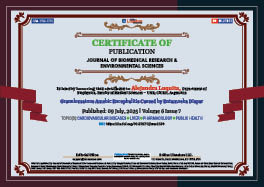Francisco Pons, Martin Perez, Mariana Ferrero, Leda Urli, Josu00e9 Gonzalvez, Juan Alonso, Daniel De Vuono, Cecilia Dobrecky, Rodolfo Leiva, Marcelo Wagner, Cristina Carnovale and Alejandra Luquita
Volume6-Issue7
Dates: Received: 2025-06-07 | Accepted: 2025-07-04 | Published: 2025-07-09
Pages: 862-867
Abstract
Ligaria cuneifolia (R. et P.) Tiegh. –Loranthaceae– (Lc), commonly used in traditional medicine, is believed to reduce total plasma cholesterol (TC) and improve blood flow.
Objective: To evaluate the effect of ingesting Lc infusions on plasma cholesterol, Whole Blood Viscosity (WBV), Hepatic Function (HF), and Renal Function (RF) in patients with cholesterol levels >200 mg/dL.
Methods: Twelve patients were studied. Baseline venous Blood samples (B) were collected for initial measurements. Each participant received freeze-dried Lc extract to be ingested as an infusion three times per week. After 31 days, post-treatment blood samples (TLc) were obtained. Plasma determinations included: TC, High-Density Lipoprotein Cholesterol (HDL-C), Low-Density Lipoprotein Cholesterol (LDL-C), urea, and creatinine using enzymatic methods (mg/dL); Alkaline Phosphatase (ALP), Alanine Aminotransferase (ALT), and Aspartate Aminotransferase (AST) using kinetic methods (U/L); and WBV using a rotational viscometer. Relative Blood Viscosity (RBV) was calculated.
Statistical analysis
Wilcoxon test for paired data. Results (median and 95% CI): TC: B: 230 (205-278); TLc: 229.6 (200-251) ns; HDL-C: B: 59 (42-84); TLc: 63.5 (35-76) ns; LDL-C: B: 185.5 (140-239); TLc: 169.5 (135-215) *; RBV: B: 2.99 (2.5-3.38); TLc: 3.05 (2.20-3.79) ns; AST: B: 21.5 (15-30); TLc: 20.5 (15-32) ns; ALT: B: 21 (6-31);TLc: 17.5 (7-27) *; ALP: B: 77 (55-100); TLc: 77 (70-100) ns; urea: B: 31.5 (22-52); TLc: 33 (22-49) ns; creatinine: B: 0.89 (0.711.22); TLc: 0.83 (0.580.13) ns. (*p < 0.05 vs B; ns = n significant vs B). Conclusion: The treatment significantly reduced LDL-C levels without altering TC, HDL-C, RBV, RF, AST, or ALP. ALT, a biochemical marker of hepatic steatosis, was also significantly reduced. Given the association between LDL-C and atherosclerosis, these findings suggest Lc could be a viable option for cardiovascular disease prevention.
FullText HTML
FullText PDF
DOI: 10.37871/jbres2139
Certificate of Publication

Copyright
© 2025 Pons F, et al., Distributed under Creative Commons CC-BY 4.0
How to cite this article
Pons F, Perez M, Ferrero M, Urli L, Gonzalvez J, Alonso J, De Vuono D, Dobrecky C, Leiva R, Wagner M, Carnovale C, Luquita A. Evaluation of the Effect of Ligaria cuneifolia Infusion on Plasma Cholesterol and Liver and Kidney Function in Patients with Cardiovascular Risk. J Biomed Res Environ Sci. 2025 Jul 09; 6(7): 862-867. doi: 10.37871/jbres2139, Article ID: JBRES2139, Available at: https://www.jelsciences.com/articles/jbres2139.pdf
Subject area(s)
References
- Costaguta M, Lus B, Gabucci L, RodrÃguez Morcelle M, Bruno L. Medicinal plants: promoting community health from an intercultural perspective. Revista de Extensión Universitaria. 2015;(4):74-79. doi: 10.14409/extension.v1i4.4594.
- Cavaliere C, Rea P, Lynch M, Blumenthal M. Herbal supplement sales experience slight increase in 2008. HerbalGram. 2009;82:58-61.
- Abbiatti D. The Argentine Loranthaceae. Revista del Museo de La Plata (New Series Botany). 1946;7:1-110.
- Wagner M, Fernández T, Varela B, Ãlvarez E, Ricco R, Hajos S, Gruñà A. Anatomical, phytochemical and immunochemical studies on Ligaria cuneifolia (R. et P.) Tiegh (Loranthaceae). Pharmaceutical Biology. 1998;36(2):1-9. doi: 10.1076/phbi.36.2.131.4604.
- Varela BG, Gruñà AA. Comparative foliar and stem anatomy of the native mistletoe and the European mistletoe. Acta Farmacéutica Bonaerense. 1995;14(1):21-29.
- Scarpa GF, Montani MC. Medical ethnobotany of “ligas†(Loranthaceae sensu lato) among indigenous and rural populations of Argentina. Dominguezia. 2011;27(2):6-19.
- Lefkowitz RJ, Hoffman BB, Taylor P. Neurohumoral transmission: The autonomic and somatic motor nervous systems. In: Goodman, Gilman, editors. The Pharmacological Basis of Therapeutics, (8th ed.), Spanish translation. Buenos Aires: Editorial Panamericana; 1991. p.97-133.
- Graciano MN, Widner GA, Coussio JD. Flavonoids from the Argentine mistletoe, Psittacanthus cuneifolia. Phytochemistry. 1967;6:1709-11.
- Varela BG, Fernández T, Taira C, Cerdá Zolezzi P, Ricco RA, Caldas López E, Ãlvarez E, Gruñà A, Hajos S, Wagner ML. The “local mistletoeâ€, Ligaria cuneifolia (R. et P.) Tiegh - Loranthaceae. From popular use to the study of pharmacological effects. Dominguezia. 2001;17(1):1-13.
- Taira CA, Wagner ML, Adrados HM, Piño R, Gruñà AA. Pharmacological study of a vasoactive agent present in Ligaria cuneifolia var. cuneifolia. Acta Farmacéutica Bonaerense. 1994;13(2):91-95.
- Mengarelli G, Dominighini A, Ferrero M, Ãlvarez ML, Wagner M, Gruñà A, Carnovale CE, Luquita A. Evaluation of hemorheological parameters and biliary secretion in Ligaria cuneifolia (Argentine mistletoe) extract treated rats. Pharmaceutical Biology. 2001;39(6):435-439.
- Dominighini A, Ferrero M, Mengarelli G, Ronco MT, de Luján Alvarez M, Wagner M, Gurni A, Carnovale C, Luquita A. Hemorrheologic changes induced by aqueous extract of Ligaria cuneifolia: treatment by two different administration routes. Clin Hemorheol Microcirc. 2004;31(2):113-21. PMID: 15310946.
- Ferrero M, Crosetti D, Dominighini A, de Luján Alvarez M, Ronco MT, Wagner ML, Gurni A, Carnovale C, Luquita A. Effect of the vehicle polyvinylpyrolidone and the Methanolic Fraction of Ligaria cuneifolia (Argentine Mistletoe) extract on hemorheological properties and biliary secretion in rats. Clin Hemorheol Microcirc. 2007;36(2):95-104. PMID: 17325433.
- Sanyal AJ, Chalasani N, Kowdley KV, McCullough A, Diehl AM, Bass NM, Neuschwander-Tetri BA, Lavine JE, Tonascia J, Unalp A, Van Natta M, Clark J, Brunt EM, Kleiner DE, Hoofnagle JH, Robuck PR; NASH CRN. Pioglitazone, vitamin E, or placebo for nonalcoholic steatohepatitis. N Engl J Med. 2010 May 6;362(18):1675-85. doi: 10.1056/NEJMoa0907929. Epub 2010 Apr 28. PMID: 20427778; PMCID: PMC2928471.
- Gonzalvez J, Garcia G, Galliano S, Dominighini A, Urli L, Monti J, Ronco MT, Frances D, Wagner M, Carnovale C, Luquita A. The Enriched Proanthocyanidin Extract of Ligaria cuneifolia Shows a Marked Hypocholesterolemic Effect in Rats Fed with Cholesterol-Enriched Diet. Recent Pat Endocr Metab Immune Drug Discov. 2017;11(1):47-53. doi: 10.2174/1872214812666180223110859. PMID: 29473534.